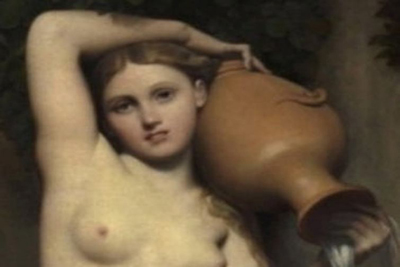
The Source, also known as the spring, created by the French neoclassical painter Jean Auguste Dominique Ingres, depicts a nude standing upright between an opening in the rocks and holding a pitcher on her shoulder with her hands, from which water flows. The nude in the painting thus symbolizes a spring, a water source, which in classical literature is sacred to the Muses and may be explained as the source of poetic inspiration. Although the pose of the nude has striking resemblance to one of his earlier creations, the Venus Anadyomene (1848), the standing nude figure in the Source is inserted in the vertical format, as if in an alcove, which gave the painting the dimension of a statue. In fact, the technique appropriate for sculpture was skillfully applied by the artist on the treatment of the painted nymph, which is absolutely striking.

Ingres began working on the Source, an oil painting on canvas, in Florence around 1820 and when it was completed with the help of his two disciples, painters Paul Balze and Alexandre Desgoffe, who created the background and water jar, he was seventy six. The nude model for the painting was the 16-year old young daughter of Ingres' concierge, which Kenneth Clark, a British art historian described as the most beautiful figure in French painting.
Ingres considered himself a painter in the tradition of Jacques-Louis David and he followed that tradition in his emphasis on line and drawing of the Source. However, he went beyond this framework and his innovative style opened the way for artists, such as Degas and Picasso. In this particular painting, the brushstroke is less shiny, more velvety on the curves of the body, as if to suggest the texture of the skin and give the illusion of flesh. The elongated body of the nude is an excuse for a play of curving lines and the treatment of the modelling gives rise to an extraordinary simplification, while the lack of depth accentuates the presence of the silhouette.

The Source, painted by Ingres was considered by many as the symbolic unity of woman and nature, where the flowering plants and water serve as a background which the artist filled with woman's secondary attributes. The painting was received enthusiastically, when it was exhibited for the first time in 1856, the year it was completed. Count Duchâtel was the first person, who acquired the painting for 25000 francs in 1857.In his house it was surrounded by large plants and aquatic flowers, so that the nymph of the spring looked even more like a real person.
Described as the exquisite dream of innocence, the Source was passed to the Louve in 1878 and finally shifted to Muse d’Orsay in 1986.
